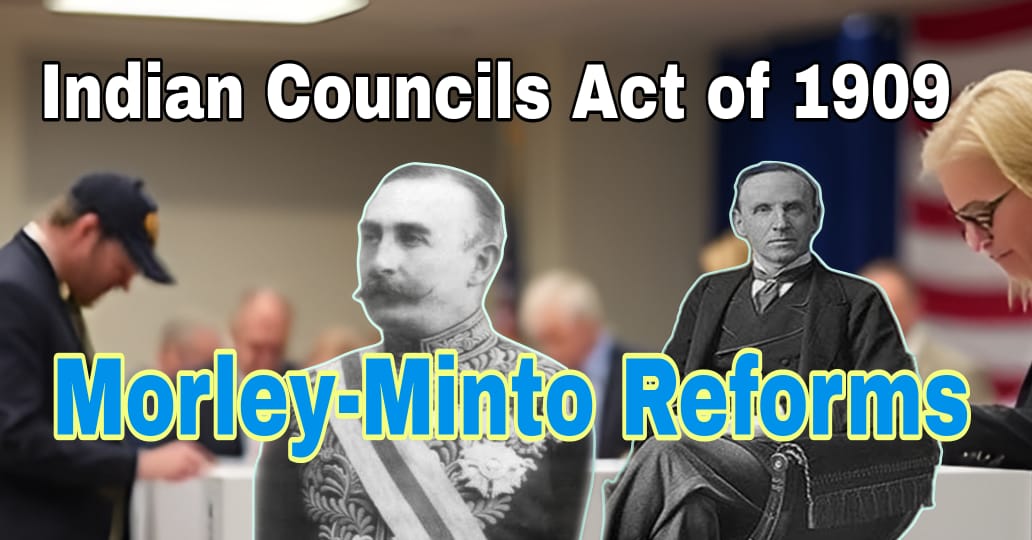Indian Councils Act of 1909 (Morley-Minto Reforms)
The Indian Councils Act of 1909, popularly known as the Morley-Minto Reforms, marked a significant milestone in the constitutional history of India. It aimed to placate growing political unrest by introducing limited reforms in governance, while simultaneously strengthening British control.
Historical Context
The early 20th century saw a surge in political consciousness in India. The partition of Bengal in 1905 and the Swadeshi movement had intensified nationalist demands. Simultaneously, the Muslim League, founded in 1906, began advocating for Muslim interests. The British Government sought to balance these conflicting demands by introducing reforms aimed at appeasing both moderate nationalists and communal interests.
Lord Morley, the Secretary of State for India, and Lord Minto, the Viceroy of India, crafted the 1909 reforms to address these challenges while maintaining British dominance.
Key Features of the Indian Councils Act, 1909
● Central Legislative Council:— The number of members was increased from 16 to 60.
● Provincial Legislative Councils:— The number of members varied from province to province, reflecting local conditions.
This expansion provided more opportunities for Indian representation, though power remained concentrated with the British.
● Central Legislative Council:— The act retained an official majority, ensuring that British officials could outvote non-official members.
● Provincial Legislative Councils:— For the first time, non-official members were given a majority, allowing limited Indian influence in provincial legislation.
Members of legislative councils were granted greater freedom to:
(i) Ask supplementary questions.
(ii) Move resolutions on the budget and other public matters.
● While these functions were largely advisory, they marked an important step toward parliamentary-style debate.
● For the first time, Indians were associated with the Viceroy’s and Governors’ Executive Councils.
● Satyendra Prasad Sinha became the first Indian member of the Viceroy’s Executive Council, serving as the Law Member.
● This inclusion symbolized a limited recognition of Indian capabilities in governance.
● The act introduced separate electorates for Muslims, allowing only Muslim voters to elect Muslim members.
● This system institutionalized communal representation and is often criticized for fostering divisions.
● Lord Minto earned the title of “Father of Communal Electorate“ for this provision.
● The act provided separate representation for:
(i) Presidency corporations
(ii) Chambers of commerce
(iii) Universities
(iv) Zamindars
● This provision aimed to include diverse interest groups in governance.
Significance of the Indian Councils Act, 1909
The act’s communal representation provisions had far-reaching consequences:
● It formalized the division of Indian society along religious lines.
● It marked the beginning of communal politics in India, which later influenced the partition of the country.
● The act expanded opportunities for Indians to participate in legislative councils and executive bodies.
● It marked a step forward in the gradual Indianization of governance, although the British retained ultimate control.
● The act’s provisions for budget discussions and resolutions laid the groundwork for parliamentary practices in India.
● It fostered political debate and encouraged the development of a political culture among Indians.
● Despite its significance, the act fell short of nationalist demands for self-governance and elected representation.
● The British intended it to appease moderates while containing the growing influence of extremists within the Indian National Congress.
Criticism of the Indian Councils Act, 1909
The introduction of separate electorates is widely criticized for:
● Dividing Indian society along communal lines.
● Encouraging communal politics that later escalated into religious tensions.
● The act retained official majorities in the Central Legislative Council and key decision-making powers with the British.
● Indians’ participation was largely symbolic, with limited influence over governance.
● The representation granted to special interest groups (e.g., zamindars, chambers of commerce) often excluded ordinary Indians.
● The act primarily catered to the elite, leaving the broader population underrepresented.
Legacy of the Indian Councils Act, 1909
The act served as a foundation for subsequent reforms, such as:
● Government of India Act, 1919 (Montagu-Chelmsford Reforms).
● Government of India Act, 1935.
Each reform built upon the principles introduced in 1909, gradually expanding Indian representation.
● The act’s communal provisions set a precedent for the separate representation of religious and communal groups, which influenced later political developments.
● It marked the beginning of a shift in nationalist politics, with growing demands for independence and communal interests asserting themselves.
● The act encouraged political debate and advocacy, fostering the growth of Indian political leaders and movements.
● It also highlighted the limitations of British reforms, strengthening demands for Swaraj (self-rule).
Conclusion
The Indian Councils Act of 1909 represented a significant yet flawed step in India’s constitutional development. While it expanded Indian representation and introduced deliberative elements in governance, it failed to address the growing aspirations for self-governance. The introduction of separate electorates for Muslims sowed the seeds of communalism, a legacy that deeply impacted India’s political landscape. Despite its limitations, the act remains an important milestone, reflecting the complexities of colonial rule and the gradual evolution of India’s political institutions.
_

